When looking for natural sweeteners and healthy alternatives to regular sugar, you may wonder about the differences between agave vs maple syrup. These two popular sweetener options have natural sugars and have been marketed as healthier alternatives to processed white sugar in recent years. Let's look at the side-by-side comparison of the two common sweeteners regarding sugars, nutrients, flavor, and health benefits.
It is no longer a secret that processed sugar causes severe health implications. From type 2 diabetes to inflammation, heart disease, and even cancer, refined sugar contributes to health decline. The good news is, that there are several natural alternative sweeteners that are a far better option than the processed counterparts.
Jump to:
Processed Sugars
There are natural sugars in a variety of fruits and vegetables; sugars and syrups can be made from several different plant-based options. Some natural sweeteners include fresh fruit, coconut sugar, date syrup, raw honey, blackstrap molasses, pure maple syrup, and agave nectar.
Be aware that even refined sugar like high fructose corn syrup or brown rice syrup claims to be natural and plant-based. They come from rice and corn that is typically genetically modified and highly processed. In fact, there are several studies indicating the dangers of processed sugars and High-fructose corn syrup.
HFCS, refined table sugar, and other similar products are mass-produced and used in many packaged products across the globe. These products have a high glycemic index and are linked to several health problems including fatty liver disease, heart disease, metabolic syndrome, insulin resistance, and more.
Artificial Sweeteners
Additionally, food companies introduced artificial sweeteners. These chemically altered substances have a sweet taste with fewer calories and carbohydrates. However, Studies have shown that they can be just as dangerous as refined sugar if not more. Artificial ingredients and processes used to create such sweeteners have a negative health effect on the body.
While these sugar substitutes may reduce sugar intake, they still have been linked to lower GI disturbances, cancer, Alzheimer's, heart disease, obesity, migraines, and more. There is a better option!
If natural sugars in fruits, honey, agave, maple, and the like aren't in the cards for you, there are still natural sugar substitute options. Monk fruit and stevia are two plant-based sweeteners that have health benefits without any of the sugars. Let's talk about the differences between Agave and Maple.
In our last sweetener comparison article, we talked about both date syrup and maple syrup. Both of these are plant-based natural sweeteners with high nutritional value and health benefits. Now let's go on to see how agave syrup compares to maple syrup!
What is Agave Nectar?
Agave nectar is a natural sweetener that is derived from the agave plant, a succulent. It is native to Mexico and the southwestern United States. There are two agave plants that nectar is derived from; the salmiana and the blue agave plant.
In many agave products, the nectar is made by extracting the sap of the agave plant, filtering and heating it to break down the complex sugars into simple sugars, and then reducing it to a syrup-like consistency.
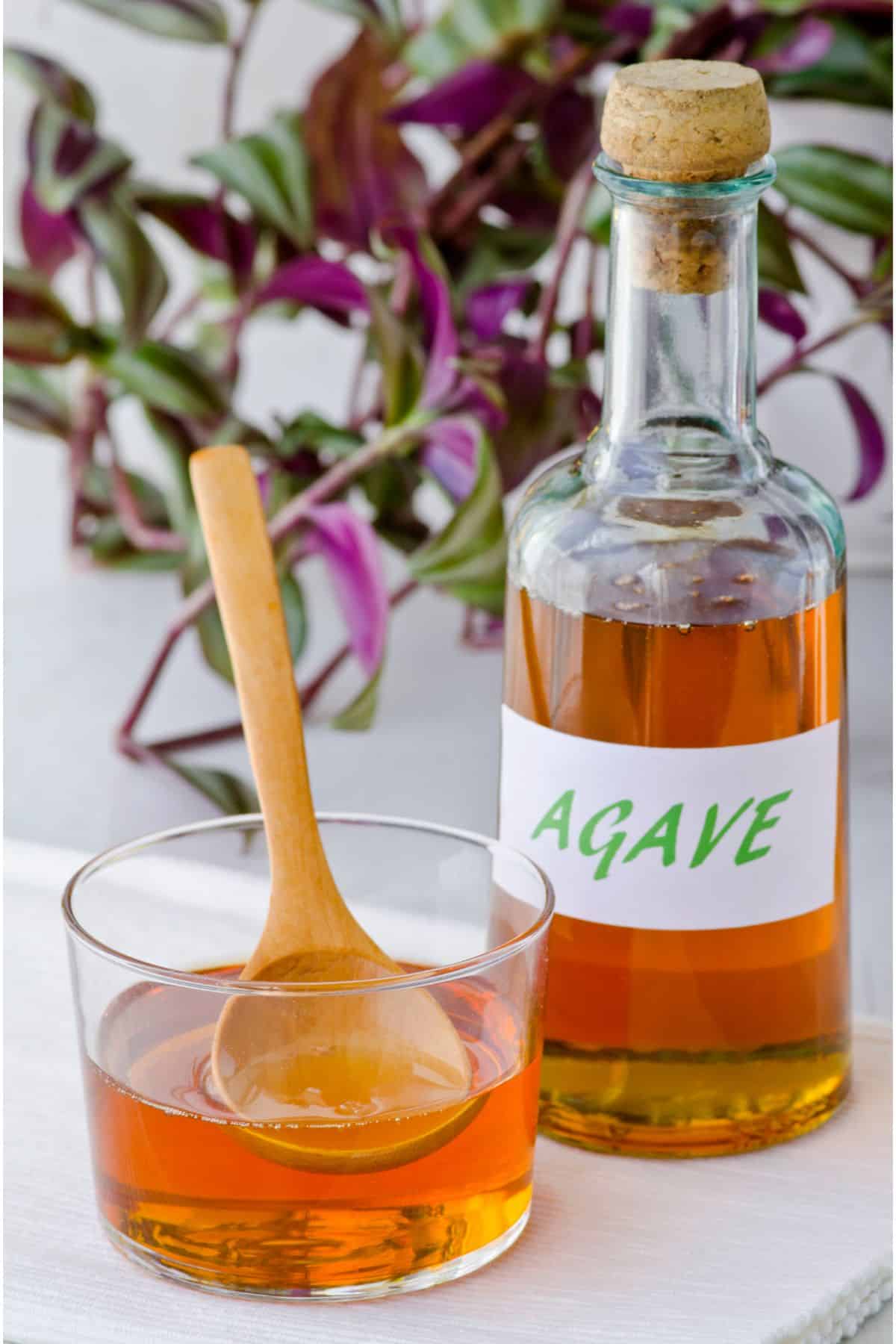
Agave nectar has gained popularity over the years as a healthier alternative to refined sugar, as it has a lower glycemic index and does not cause the same rapid spikes and crashes in blood sugar levels. It is actually sweeter than sugar, so less is needed to achieve the same level of sweetness. However, some scholars indicate that, despite the lower GI, the higher fructose content of agave causes it to be higher in calories than table sugar.
Agave nectar comes in a range of colors, from light to dark amber, and has a mild, slightly caramel-like flavor. It can be used as a substitute for sugar in a variety of recipes, such as beverages, baked goods, and marinades.
Light vs Dark Agave
There are two main types of agave nectar: light and dark. The primary difference between the two is the level of processing they undergo.
- Light agave nectar: This type of agave nectar undergoes minimal processing and is often called "raw" or "blonde." It has a light color and a mild, delicate flavor that is similar to honey. Light agave nectar is often used as a sweetener in beverages and desserts, and it is also a popular choice for vegan baking.
- Low glycemic index: Light agave nectar has a lower glycemic index than many other sweeteners, meaning it does not cause a rapid spike in blood sugar levels.
- Fructose content: The raw version of agave has less sugar than its counterpart. However, new studies indicate that agave's higher fructose content makes it less healthful than once thought. High fructose is linked to fatty liver disease and is best limited.
- More antioxidants exist in the raw or light version than in its heat-processed counterpart.
- Dark agave nectar: This type of agave nectar undergoes a longer cooking process, which caramelizes the sugars and gives them a darker color and a stronger, more complex flavor. It is often used as a sweetener in savory dishes, such as marinades, salad dressings, and sauces.
- Rich flavor: Dark agave nectar has a rich, caramel-like flavor that can add depth to savory dishes.
- Low glycemic index: Due to the extended processing, it is higher in sugar and GI than the raw counterpart.
Overall, raw agave nectar can be a healthier alternative to refined sugar, as it has a lower glycemic index and higher antioxidant content. However, it is still important to use them in moderation, as they are still a high source of fructose, calories and carbohydrates. For diabetics, it is recommended to avoid higher fructose, since agave may inhibit insulin production.
Agave Products
When looking for an agave nectar product, it is important to vet the company that it is being produced by and the processes it uses. The raw version is subjected to minimal heat, which retains the nutrients more substantially than the agave that has been heated excessively. Also, be sure to read the ingredients to ensure that there aren't any added sugars or ingredients.
 Wholesome Sweeteners 44-Oun...Shop on Amazon
Wholesome Sweeteners 44-Oun...Shop on Amazon
 Madhava Naturally Sweet Org...Shop on Amazon
Madhava Naturally Sweet Org...Shop on Amazon
Nutrients in Agave
Agave nectar contains small amounts of antioxidants, mainly in the form of flavonoids. Flavonoids are plant compounds that have antioxidant properties and can help protect against oxidative stress and inflammation in the body.
However, the levels of antioxidants in agave nectar are relatively low compared to other natural sources like fruits, vegetables, and whole grains. By the same token, agave has minerals, vitamins, and nutrients in trace amounts. These amounts are much less than other natural sweeteners like honey, maple, and date syrup.
What is Maple Syrup?
Pure maple syrup is a natural sweetener made from the sap of the maple tree. It is a popular alternative to refined sugar and is commonly used in baking, cooking, and as a topping for pancakes and waffles.
Maple is produced primarily in the northeastern region of North America, including Canada and the United States. The sap is harvested from the sugar maple tree in the late winter and early spring when the temperatures begin to rise above freezing during the day and fall below freezing at night.
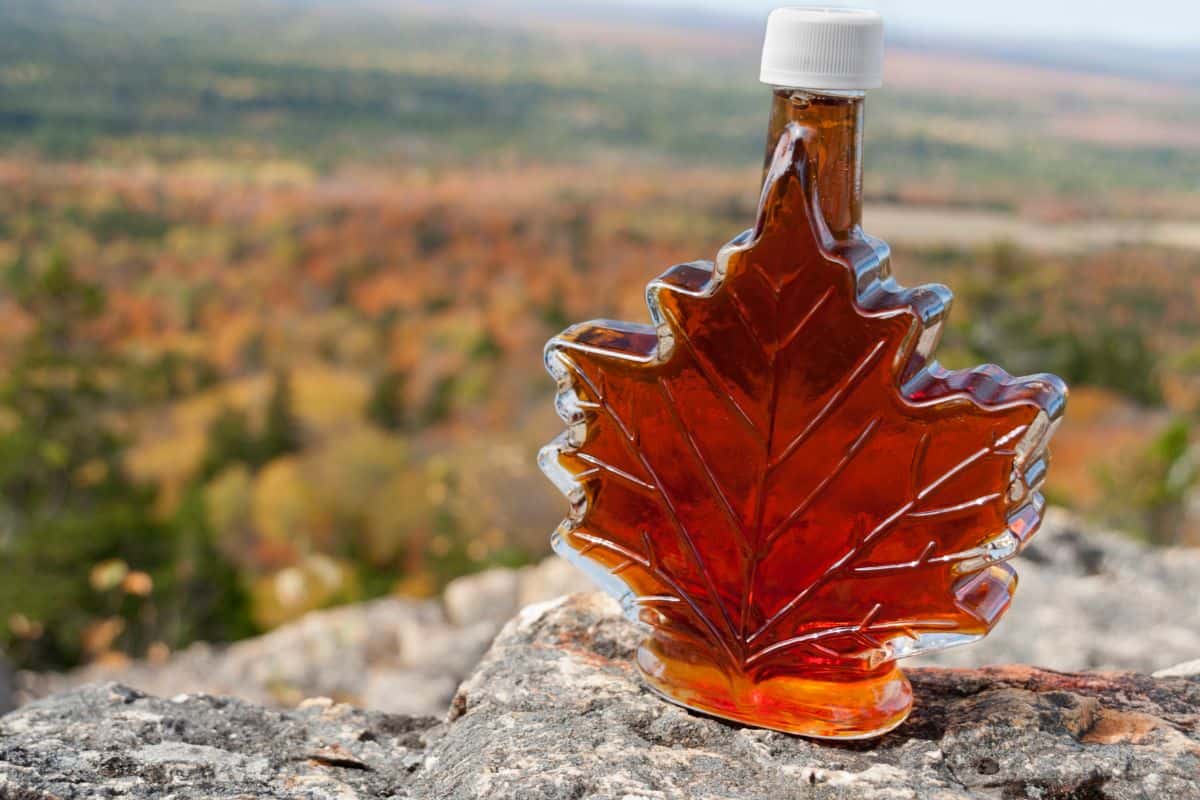
To produce maple syrup, small holes are drilled into the trunk of the maple tree, and a spout is inserted to allow the sap to flow into a collection container. The sap is then boiled in large pans to evaporate the water content and concentrate the sugars. This results in the thick, sweet liquid known as maple syrup.
The process of making maple syrup has been practiced for centuries by indigenous peoples of North America. It continues to be a tradition for many communities in the region today. Maple syrup is highly valued for its unique flavor and nutritional properties and is a beloved part of many culinary traditions.
Maple Flavored Syrup
There are several breakfast syrups that are used and sold commercially that mimic the natural flavor and consistency of pure maple syrup. Simple syrups like Aunt Jemima and other popular brands have been around for decades and became a staple in the standard American kitchen.
When looking at the label of these syrups you might find many different ingredients including refined added sugars. We highly recommend reviewing the importance of pure maple vs imitation syrups.
Pure Maple Syrup
Using pure maple syrup is important for several reasons. Firstly, pure maple syrup has a richer and more complex flavor compared to artificial or imitation syrups. It has a unique taste that is difficult to replicate.
In addition to its flavor, pure maple syrup contains a variety of nutrients, including minerals such as calcium, potassium, and zinc. It also contains antioxidants, which can help protect against cellular damage and inflammation.
Furthermore, pure maple syrup does not contain any additives, preservatives, or artificial sweeteners. This means that it is a natural and healthier option compared to syrups that contain high fructose corn syrup or other artificial ingredients.
Lastly, maple syrup is produced using sustainable and ethical methods. The methods involve tapping the trees for sap and boiling it down into syrup. This process does not harm the trees, and it supports local communities that rely on maple syrup production as a source of income.
 Coombs Family Farms Maple S...Shop on Amazon
Coombs Family Farms Maple S...Shop on Amazon
 Escuminac Canadian Maple Sy...Shop on Amazon
Escuminac Canadian Maple Sy...Shop on Amazon
Pure Maple vs Simple Syrup
Overall, using pure maple syrup is a healthier and more sustainable choice compared to artificial or imitation syrups. It provides a unique flavor and nutritional value that cannot be replicated and a host of health benefits.
Speaking from experience, once you taste pure maple syrup, it will be difficult to go back to using imitation sweet syrup with "maple flavor". Especially knowing the benefits of pure maple, our family felt really good making the switch and paying the extra money for the quality nutrients we are receiving.
Health Benefits: Maple vs Agave
While both agave and maple are healthier natural alternatives to refined sugar, they differ in nutritional value and health benefits.
Maple syrup contains a variety of nutrients, including calcium, potassium, zinc, and manganese. It also contains antioxidants, which is an additional nutritional boost. In addition, maple syrup has a lower glycemic index compared to refined sugar. This means it can help regulate blood sugar levels and may be a better option for people with diabetes.
On the other hand, agave nectar is higher in fructose than maple. Fructose is a type of sugar that has been linked to an increased risk of obesity, insulin resistance, and other health problems when consumed in large amounts.
While agave nectar does contain some antioxidants and may have a slightly lower glycemic index compared to refined sugar, these benefits may be outweighed by its high fructose content and minimal nutrient profile.
In terms of calories and carbohydrates, maple syrup and agave nectar are similar. They have approximately 52-60 calories and 13-17 grams of carbohydrates per tablespoon.
Overall, while both maple syrup and agave nectar can be used as natural sweeteners, pure maple syrup may be a better option. This is due to its higher nutritional content, lower glycemic index, and lower fructose content compared to agave nectar. However, it's important to use either sweetener in moderation. They still contain sugar and can contribute to excess calorie intake if consumed in large amounts.
Nutrition Comparison
Here is a table comparing the nutrition information for 1 tablespoon (20g) of pure maple syrup vs 1 tablespoon (21g) of agave nectar:
| Nutrient | Pure Maple Syrup | Agave Nectar |
|---|---|---|
| Calories | 52 | 60 |
| Total Carbohydrates | 13g | 16g |
| Sugars | 12g | 16g |
| Calcium | 2% DV | - |
| Potassium | 1% DV | 1% DV |
| Zinc | 2% DV | - |
| Manganese | 22% DV | - |
| Antioxidants | Yes | Some |
| Glycemic Index | 54 | 15-30 |
As you can see from the table, pure maple syrup is slightly lower in calories and total carbohydrates compared to agave nectar. Maple syrup also contains more nutrients such as calcium, potassium, zinc, and manganese. It also has a higher level of antioxidants compared to agave nectar.
Additionally, pure maple syrup has a higher glycemic index compared to agave nectar. This means it can cause a slightly larger increase in blood sugar levels. However, it is important to note that both sweeteners should be used in moderation. They still contain sugar and can contribute to excess calorie intake if consumed in large amounts.
in conclusion, agave and maple syrup are both better options than regular table sugar. They even contain some nutrients and antioxidants! Maple has a bit more nutrients than agave.
Personally, we love maple syrup and use it in dishes, desserts, and drinks regularly! As a certified holistic nutrition specialist and coach, I recommend that if you are concerned about sugars, choose pure monk fruit or pure stevia for natural sugar-free sweeteners.
And of course, be sure to discuss your lifestyle and dietary choices with your healthcare provider before starting anything new.
What is your favorite sweetener? Let us know in the comments below!
Be well,
Natalie

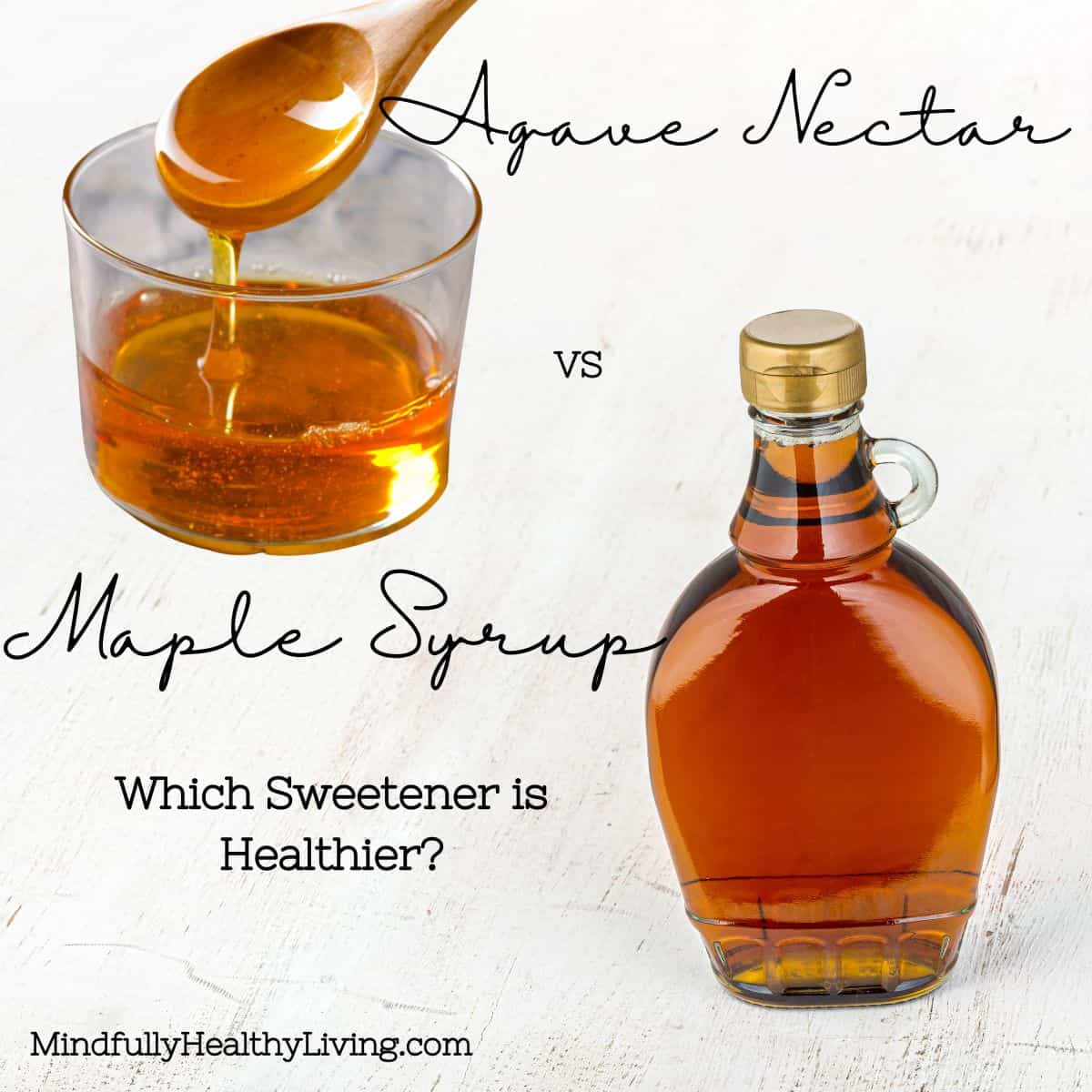
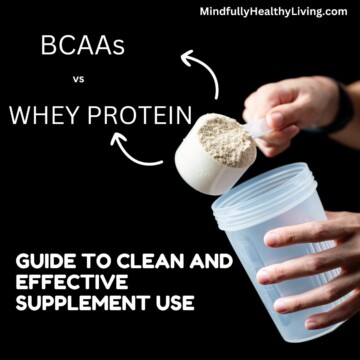
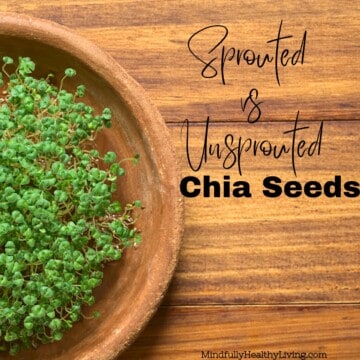
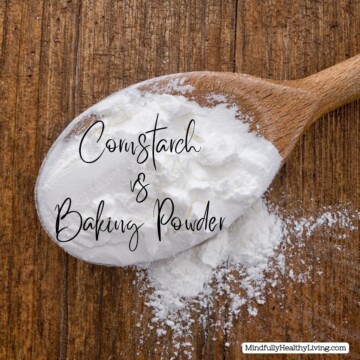

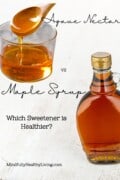
Katherine McLee says
This was such an interesting read! I've been using agave for a while now but never even registered that maple syrup could be a good/better option! Thank you!
Natalie Perry says
It all depends on your specific needs! Agave is great, however Maple has more nutrients. Either way, they are both better than table sugar. Way to go, eating naturally. Thank you for sharing 🙂